Galleries
Meet the New Generation of Young London Art Dealers
Discover the rising galleries that are keeping London young, weird, and interesting.
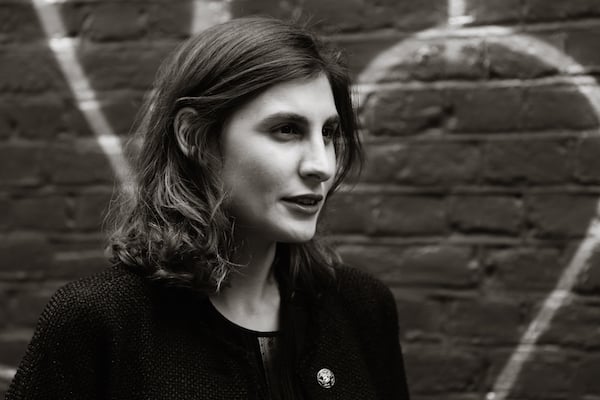
Photo: (c) Annas Lichter Roman Road
Discover the rising galleries that are keeping London young, weird, and interesting.

Lorena Muñoz-Alonso


London
Photo: via Wikipedia
London, home to a seemingly unending selection of commercial galleries, top-notch museums, and the ever-powerful Frieze fair, is the European art center par excellence. But with real estate prices rocketing and a fiercely competitive gallery scene, it might seem like a daunting space to launch such a high-risk enterprise such as a young gallery.
Not for these young dealers, though, who all braved the odds and opened their commercial spaces in the wake of the recession. Some of them—like The Sunday Painter and Arcadia Missa, both in South London, Supplement in East London, and Kinman—started as non-profit projects spaces before turning into full-fledged galleries a few seasons later. Others, like Carlos Ishikawa and Southard Reid, took the plunge without safety net, as its founders had had previous experience working for established commercial galleries and had gathered enough contacts and know-how.
Despite the huge amounts of capital exchanging hands in the city on a daily basis and its thriving cultural scene, however, London’s been getting a substantial amount of bad press of late due to the high cost of living in the city. But still, the pros outweigh the cons for these gallerists.
As Harry Beer from The Sunday Painter gallery put it: “London is definitely facing some serious and worrying issues at the moment around higher-education, property prices, and public funding cuts, that all threaten the future of London as a capital for culture, and indeed a place to live. However, it is a busy, thriving place that lures interesting, odd, and ambitious people.”
“Everywhere I go, I’m always so happy to come back to London, it’s a privilege to live somewhere so inherently progressive,” Vanessa Carlos, from Carlos Ishikawa, chimed in. Meanwhile, Henry Kinman told artnet News that “London’s artistic community has a history of thriving in such circumstances.”
Meet the rising generation of art dealers that are keeping London young, weird, and interesting.
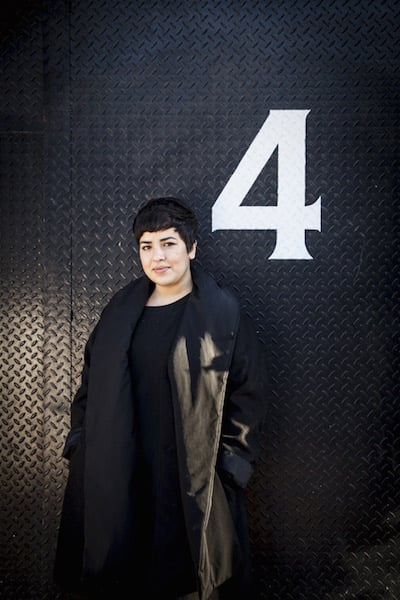
Vanessa Carlos, founder and director of Carlos/Ishikawa.
Photo: Courtesy the gallery.
The gallery, founded by Vanessa Carlos in 2011, famously discovered and starting representing Oscar Murillo (pre-Rubells and pre-David Zwirner) when he was just a struggling young artist, cementing Carlos’s reputation to spot artists with star potential.
Carlos worked for a number of commercial galleries (including Gagosian, Modern Art, and The Approach) and ran a non-profit space before setting up shop. “I never considered opening my own gallery,” she told artnet News. “The opportunity came because a childhood friend needed to invest some money in a business for a visa so we decided to go in together.”
Its current roster includes Murillo, Korakrit Arunanondchai, Pilvi Takala, Richard Sides, Marie Angeletti, Lloyd Corporation, Stuart Middleton, Steve Bishop, and Ed Fornieles.
“I’m interested in artists who aren’t straightforward object-makers and whose concepts manifest themselves in whichever medium makes sense for that idea,” Carlos told artnet News. “Most of the artists we show work across all or most of these mediums: film, performance, installation, painting, sculpture, photography, writing, online. I’m also quite devoted to the notions that Brazilian artists in the ’60s had of using sensory engagement as a socio-political and democratic entry point to their work. I guess that’s what I’ve heard people scoff at as ‘Carlos/Ishikawa experiential shit!’”
The “experiential shit” seems to be working really well, and the gallery has earned quite a reputation for its maverick art fair presentations, having participated in Liste in Basel, Frieze London, Frieze New York, MiArt in Milan, ARCO in Madrid, Paramount Ranch in Los Angeles, and Independent in New York.
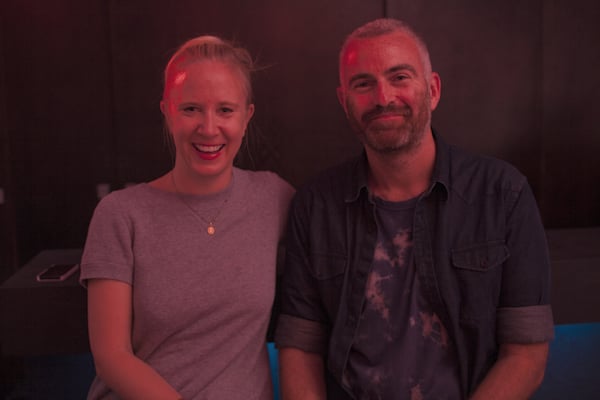
Phillida Reid and David Southard of Southard Reid.
Photo: Courtesy the gallery.
David Southard and Phillida Reid were a pair of good friends working in the arts (Southard for Hauser & Wirth and the artist Martin Creed, and Reid for Anthony d’Offay and then Waddington Custot Galleries) when they decided to launch Southard Reid in 2010.
“We had both been in the art world for some time and felt there was an opportunity to work with the artists we already knew,” they told artnet News. Of all the galleries featured in this list, Southard Reid probably has the most central location, in a quiet and beautiful mews bang in the middle of Soho, whose streets are perennially heaving with people coming and going to nearby bars, restaurants, cinemas, and theaters.
Entering the inconspicuous mews, in Southard Reid’s split level gallery, a fantastic program of emerging artists has been unfolding for the past four years. The gallery represents Hany Armanious, Mark Barker, Sam Belinfante, Lea Cetera, Benny Chirco, Ann Craven, Celia Hempton, Neal Jones, Alec Kronacker, Daniel Lipp, Joanna Piotrowska, Prem Sahib, and Edward Thomasson, of whom a good number are living and working in the capital.
“London remains inspiring and exciting, and the acceleration that’s going on just means that we all have to adapt,” they told artnet News. “In some ways the sharpened environment creates more clarity and responsibility and gallerists have a strongly navigational role.”
Southard Reid has participated in Frieze London, Independent, Miart, and ARCO, and is about to take part in the first edition of the art fair SPRING 1883 in Sydney, starting on September 9.
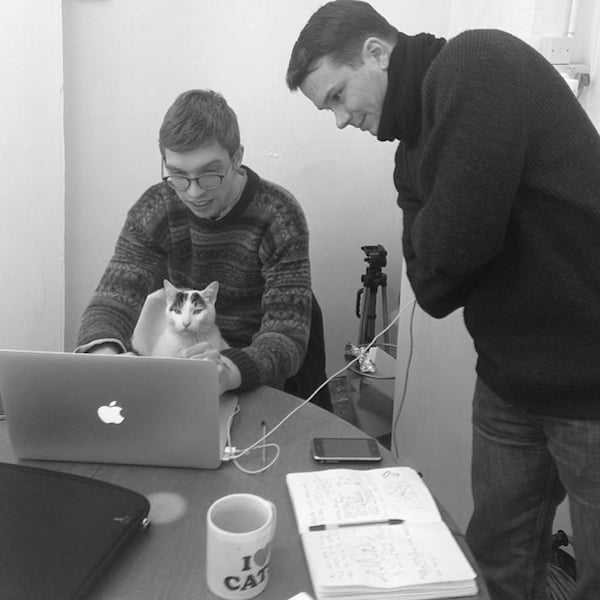
Thom O’Nions and Adam Thomas, founder and directors of Supplement
Photo: Courtesy the gallery
Thom O’Nions and Adam Thomas launched Supplement as a project space in 2010 in a prime location in East London, between Bethnal Green and Hackney Road. “We were a project space for an abnormally long amount of time, sustained by incredibly cheap rent, which doesn’t really exist in London now,” O’Nions told artnet News. “We wanted to work with artists more long-term, as they developed, so we decided to start representing people.”
They took the plunge to become a commercial gallery in 2013, focusing on solo exhibitions by emerging artists, offering them their first solo presentation in London in many cases. Their current roster of artists includes Ben Cain, Sarah Forrest, Lauren Keeley, Matthew Musgrave, Philomene Pirecki, and Jack Vickridge.
“It was a difficult time but the young artists that come out of London are amazing and there’s such a fantastic scene here,” O’Nions told artnet News. “And we thought that if you start when everything is terrible then things can only get better!”
Supplement has participated in the fairs MiArt, Frieze NY and Sunday, the small-sized but expertly curated art fair devoted young and smaller galleries that runs parallel to Frieze London. This year, in fact, O’Nions and Thomas are taking the baton from Rob Tufnell and will organize the forthcoming edition of Sunday.
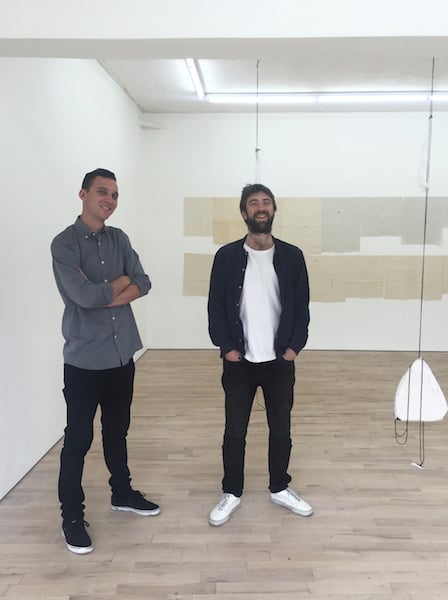
Will Jarvis (left) and Harry Beer (right), founders and directors of The Sunday Painter
Photo: Courtesy the gallery
The Sunday Painter (TSP) is located in Peckham, the south London area which has succeeded Shoreditch and Hackney—now drowned in gentrification and unrealistic rent prices—as the area of choice for young artists and creatives.
Launched in 2009 as a project space by Harry Beer and Will Jarvis, TSP officially became a commercial gallery in 2013. “We realized the project could only continue in a meaningful way if we changed the model,” Beer told artnet News. Tom Cole, who previously ran a now-shuttered eponymous gallery, recently joined the team as a third director.
The gallery represents Leo Fitzmaurice, Rob Chavasse, Piotr Lakomy, and Samara Scott, who seem to share an interest in installation, sculpture, and new media. “We tend to lean towards stuff that’s a bit weird, and I guess we haven’t actually shown that much painting, despite our name,” Beer told artnet News.
TSP has participated in NADA NY and Miami and MiArt, and this year they will have a booth in Frieze London for the first time, where they will showcase Scott’s work. “Fairs are obviously great place to meet new people in the industry and collectors,” Beer told artnet News. “However, for younger galleries at least, the sale margins can actually be very small given the large costs. I think most people prefer seeing shows at galleries; fairs can often be the worst place to experience art.”
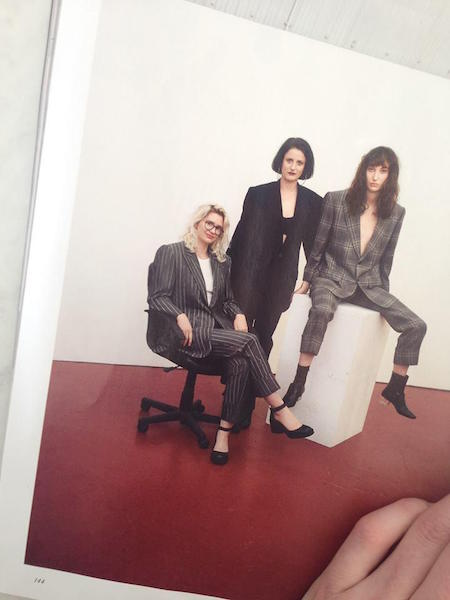
Rosza Farkas (center), founder and director of Arcadia Missa.
Photo: Courtesy the gallery.
Like The Sunday Painter, Rosza Farkas also launched Arcadia Missa in Peckham. That happened in 2011, when Farkas, who had recently graduated from art school, found a suitable location under the arches of a railway. “I wanted to set up a space that could function as a place of assembly of sorts, and where I could show artists that I had been following, who were exhibiting their work online, but that weren’t getting shown in galleries in London,” she told artnet News.
Last year, the project space became a full-fledged commercial gallery, representing the work of Amalia Ullman, Harry Sanderson, Maja Cule, Jesse Darling, and Ann Hirsch. Work made in the media of moving image, animation, and web-based technologies feature heavily in the roster, as do text-based works, as Arcadia Missa also runs a printing program to complement the exhibitions.
“We represent artists we have worked with for a while, and we are interested in art that makes comment to something other than art itself,” Farkas told artnet News. “This is often social and/or political, and does so in a way that is reflective of the society we are in.”
Arcadia Missa participated in the last edition of Liste and will take part in Frieze London in October, but Farkas is not blinded by the increasing prevalence of the fair model. “I think that we will see the current prevalence of fairs drop; there are too many,” she said. “I love the physical gallery for the reason I wanted to open one: as a place of assembly, for people to meet and discuss things outside of an exchange such as having to buy an overpriced coffee or beer.”
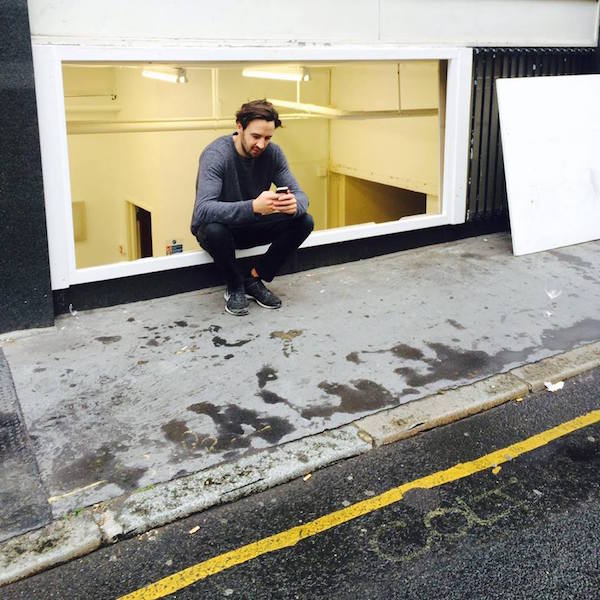
Henry Kinman, founder and director of Kinman
Photo: Courtesy of Ryan Conrad Sawyer
Henry Kinman cut his teeth with photographer Mario Testino, for whom he worked as in-house advisor and collection manager after graduating from art school in 2010. “This role really did give me an unprecedented insight into the art world as an industry,” Kinman told artnet news. “I met a lot of dealers, artist, and curators from around the world, and I began to think seriously about opening my own gallery.”
The gallery began in 2013 as a project space, where Kinman curated group shows featuring London-based artists from his social group alongside more established artists such as Thomas Hirschhorn, Amanda Ross-Ho, and Matthew Darbyshire. A few months later, he made the transition to become a commercial gallery. “Contrary to popular belief, a recession can actually be a fantastic environment for a start-up,” he told artnet News. “A lot of London’s very young galleries had closed in the post market crash, so I didn’t really have much competition.”
Kinman now works consistently with Richard Gasper, Maximilian Schubert, Rebecca Ackroyd, Dustin Pevey, Guy Patton & Peter Sutherland, and will be announcing a formal roster before the end of the year.
The gallery has participated in NADA Miami Beach for the last few years —a fair Kinman considers key for young galleries—as well as NADA New York, Miart, and Material Art Fair in Mexico City. This October, Kinman will be presenting work at (Off)icielle in Paris (which runs alongside FIAC).
Last November, Kinman also launched a project space in New York, since about 50 percent of the artists he works with are based there. “The density of collectors and artists In London is no way near as complex as in New York, but the thing that sets London apart is its unprecedented role as an international hub, linking European and American markets,” he told artnet News.
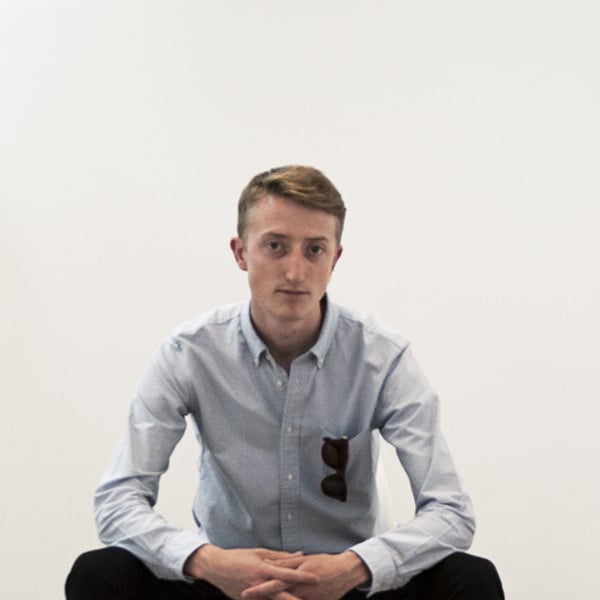
Will Lunn, founder and director of Copperfield
Photo: Courtesy the gallery
Copperfield founder and director Will Lunn was previously a partner in the gallery Sumarria Lunn, but decided to fly solo in 2014, when he found the perfect space in Southwark, south London.
With a roster of artists that includes Alastair Mackie, Darren Harvey-Regan, David Rickard, Eric Van Hove, the duo littlewhitehead, Oscar Santillan, Rä di Martino, and Tom Dale, the fair circuit has proved crucial for the development of the young gallery. “Some of the best fairs in our first year were Artissima, Art Brussels, and to my surprise, Art Rotterdam, which actually outperformed all others in some respects,” Lunn told artnet News.
Interestingly, of all the dealers participating in this piece, Lunn was the only one that didn’t wax lyrical when asked about the possibilities and advantages of being located in the British capital. “I wasn’t set on London to be honest,” Lunn admitted to artnet News. “I think that the gallery might equally be in Brussels or any number of other locations. After all, things are becoming ever more global.”

Marisa Bellani, founder and director of Roman Road.
Photo: (c) Annas Lichter Roman Road.
Roman Road was established in 2013 by Marisa Bellani, a law student who moved to London via Brussels and Paris, after she found an enticing warehouse space in the east London area of Bethnal Green.
“Looking back, I’d say that I naively opened Roman Road,” Bellani told artnet News. “I only knew a handful of people in the so-called art world and not many collectors. But this was actually really positive for me. Since not many people knew about the gallery, I had the freedom to grow organically, and I also felt that I had nothing to lose.”
Roman Road has a focus on photography, but the artists represented by the gallery—Thomas Mailaender, Aida Silvestri, and Antony Cairns—tend to use the photographic medium as a starting point for elaborate and beguiling installations. As a relative to newcomer to the city, Bellani still sees it with the best possible eyes, while remaining aware of its intrinsic problems.
“The rising prices in London are not just difficult for artists, it certainly also pushes artist studios and smaller galleries away,” she told artnet News. “But compared to other cities, we are fortunate that there is a deep passion for the arts and collecting in London. The support I have had for my gallery has been a reflection of this.”
Roman Road has recently participated in the inaugural edition of Photo London, and will be taking part in START Art Fair, which will take place in London in September.
Related stories:
14 Young New York Art Dealers To Watch
Meet The Next Generation of Berlin Art Gallery Dealers
Europe’s Top 55 Galleries You Need To Know—Part 1 and Part 2